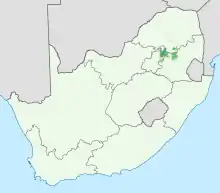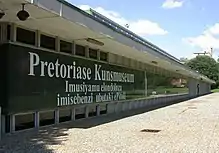Southern Ndebele language
Southern Ndebele (English: /ɛndəˈbiːliː/), also known as Transvaal Ndebele[1] or South Ndebele,[4][5] is an African language belonging to the Nguni group of Bantu languages, spoken by the Ndebele people of South Africa.
| Southern Ndebele | |
|---|---|
| Transvaal Ndebele | |
| isiNdebele seSewula | |
| Native to | South Africa |
| Region | Mpumalanga, Limpopo, Gauteng, North West |
Native speakers | 1.1 million (2011 census)[1] 1.4 million L2 speakers (2002)[2] |
| Latin (Ndebele alphabet) Ndebele Braille | |
| Signed Ndebele | |
| Official status | |
Official language in | |
| Language codes | |
| ISO 639-1 | nr – South Ndebele |
| ISO 639-2 | nbl – South Ndebele |
| ISO 639-3 | nbl – South Ndebele |
| Glottolog | sout2808 |
S.407[3] | |
| Linguasphere | 99-AUT-fi + 99-AUT-fj |

|
0–20%
20–40%
40–60% |
60–80%
80–100% |

|
<1 /km²
1–3 /km²
3–10 /km²
10–30 /km²
30–100 /km² |
100–300 /km²
300–1000 /km²
1000–3000 /km²
>3000 /km² |

There is also a different language called Northern Ndebele or isiNdebele, Matabele, or simply Ndebele, spoken in Zimbabwe, which is closer to Zulu.[6]
Overview
The Southern Transvaal Ndebele people's history has been traced back to King Ndebele, King Ndebele fathered King Mkhalangana, King Mkhalangana fathered King Mntungwa (not to be confused with the Khumalo Mntungwa, because he was fathered by Mbulazi), King Mntungwa fathered King Jonono, King Jonono fathered King Nanasi, King Nanasi fathered King Mafana, king Mafana fathered King Mhlanga and Chief Libhoko, King Mhlanga fathered King Musi and Chief Skhube.
Ndebele – Some of his sons were left behind with the Hlubi tribe
Mkhalangana – Some of his sons branched north and formed the Kalanga tribe
Mntungwa – Founder of the amaNtungwa clan
Njonono – He died in Jononoskop near Ladysmith – Surname Jonono is in the Hlubi tribe
Nanasi – He died in Jononoskop near Ladysmith – Surname Nanasi is in the Hlubi tribe
Mafana – He died in Randfontein (Emhlangeni)
Mhlanga – He died in Randfontein (Emhlangeni)
Musi – He died in kwaMnyamana (Pretoria)
King Musi's kraal was based at eMhlangeni a place named after his father Mhlanga, the name of the place is currently known as Randfontein (Mohlakeng) and later moved to KwaMnyamana which is now called Emarula or Bon Accord in Pretoria. King Musi was a polygamist and fathered the following sons, Skhosana (Masombuka), Manala (Mbuduma), Ndzundza (Hlungwana), Thombeni (Kekana or Gegana), Sibasa, Mhwaduba (Lekhuleni) and Mphafuli and others.
Southern Transvaal Ndebele is one of the eleven official languages in the Republic of South Africa. The language is a Nguni or Zunda classification (UN) spoken mostly in the Mpumalanga Province, Gauteng, Limpopo and the Northwest.
The expression "isikhethu" can be loosely translated to mean 'the Southern Ndebele way of doing or saying'. Isikhethu means Southern Ndebele the same way that sikitsi will mean Swazi and se harona will mean Sotho. The language has been severely marginalised over the years. Until the formation of the apartheid Southern Ndebele homeland (KwaNdebele), speaking the language publicly was discouraged. Most Southern Transvaal Ndebele speakers preferred Zulu especially because the latter was learned at school. Today the Southern Ndebele speakers, mostly those who are educated still prefer to use Southern Ndebele as home language for their children and will use Southern Ndebele as a language to communicate with other Southern Ndebele speakers.
Phonology
Consonants
| Bilabial | Labio- dental |
Alveolar | Palatal | Velar | Glottal | ||
|---|---|---|---|---|---|---|---|
| Plosive | ejective | p [pʼ] | t [tʼ] | k [kʼ] | |||
| aspirated | ph [pʰ] | th [tʰ] | kh [kʰ] | ||||
| devoiced | bh [b̥] | d [d̥] | ɡ [ɡ̊] | ||||
| prenasal | mp [ᵐp] | nt [ⁿt] | nk [ᵑkʼ] | ||||
| prenasal (vd.) | mb [ᵐb] | nd [ⁿd] | ng [ᵑɡ] | ||||
| implosive | b [ɓ] | ||||||
| Fricative | plain | f [f] | s [s] | rh [x] | |||
| voiced | v [v] | z [z] | h [ɦ] | ||||
| prenasal | mf [ᶬf] | ||||||
| prenasal (vd.) | mv [ᶬv] | ||||||
| Nasal | m [m] | n [n] | ny [ɲ] | ngh [ŋ] | |||
| Lateral Fricative | plain | hl [ɬ] | |||||
| voiced | dl [ɮ] | ||||||
| aspirated | dlh [ɮʰ] | ||||||
| Rhotic | r [r] | ||||||
| Lateral Approximant | l [l] | ||||||
| Approximant | w [w] | y [j] | |||||
| Alveolar | Post- alveolar |
Velar | |||
|---|---|---|---|---|---|
| Affricate | voiceless | ejective | ts [tsʼ] | tj [tʃʼ] | kg [kxʼ] |
| aspirated | tsh [tsʰ] | tjh [tʃʰ] | kgh [kxʰ] | ||
| lateral | tl [tɬʼ] | ||||
| lateral (asp.) | tlh [tɬʰ] | ||||
| voiced | plain | dz [dz] | |||
| devoiced | j [d̥ʒ] | ||||
| prenasal | nj [ᶮdʒ] | ||||
Consonant sounds nt, nd, k, mf, and mv often result in allophones of [d̥r dr k̬ ɱp̪fʼ ɱb̪v].[7]
Grammar
Nouns
The Southern Ndebele noun consists of two essential parts, the prefix and the stem. Using the prefixes, nouns can be grouped into noun classes, which are numbered consecutively, to ease comparison with other Bantu languages.
The following table gives an overview of Southern Ndebele noun classes, arranged according to singular-plural pairs.
| Class | Singular | Plural |
|---|---|---|
| 1/2 | um(u)-1 | aba-, abe- |
| 1a/2a | u- | abo- |
| 3/4 | um(u)-1 | imi- |
| 5/6 | i-, ili-, ilu- | ama- |
| 7/8 | is(i)- | iz(i)-, iiN- |
| 9/10 | iN- | iiN- |
| 14 | ubu-, ub-, utj- | |
| 15 | uku- | |
| 17 | uku- |
1 umu- replaces um- before monosyllabic stems, e. g. umuntu (person).
Verbs
Verbs use the following affixes for the subject and the object:
| Person/ Class |
Prefix | Infix |
|---|---|---|
| 1st sing. | ngi- | -ngi- |
| 2nd sing. | u- | -wu- |
| 1st plur. | si- | -si- |
| 2nd plur. | ni- | -ni- |
| 1 | u- | -m(u)- |
| 2 | ba- | -ba- |
| 3 | u- | -m(u)- |
| 4 | i- | -yi- |
| 5 | li- | -li- |
| 6 | a- | -wa- |
| 7 | si- | -si- |
| 8 | zi- | -zi- |
| 9 | i- | -yi- |
| 10 | zi- | -zi- |
| 14 | bu- | -bu- |
| 15 | ku- | -ku- |
| 17 | ku- | -ku- |
| reflexive | -zi- |
Examples
Months in Southern Ndebele
| English | Northern Ndebele (Zimbabwe) | Southern Ndebele (South Africa) | Zulu (South Africa) |
|---|---|---|---|
| January | uZibandlela | uTjhirhweni | uMasingane |
| February | uNhlolanja | uMhlolanja | uNhlolanja |
| March | uMbimbitho | uNtaka | uNdasa |
| April | uMabasa | uSihlabantangana | UMbasa |
| May | uNkwekwezi | uMrhayili | UNhlaba |
| June | uNhlangula | uMgwengweni | UNhlangulana |
| July | uNtulikazi | uVelabahlinze | uNtulikazi |
| August | uNcwabakazi | uRhoboyi | UNcwaba |
| September | uMpandula | uKhukhulamungu | uMandulo |
| October | uMfumfu | uSewula | uMfumfu |
| November | uLwezi | uSinyikhaba | uLwezi |
| December | uMpalakazi | uNobayeni | uZibandlela |
AmaNdebele in Zimbabwe
Zimbabwean Ndebele is part of the Nguni cluster and is therefore very similar to other Nguni languages (such as Zulu, Xhosa and Swati) with which it shares a high level of mutual intelligibility. However, it has (to some extent) also been influenced by other Non-Nguni Zimbabwean languages (e.g. Shona). The South African (or Southern Transvaal Ndebele), while maintaining its Nguni roots, has been influenced by the Sotho languages.[7]
References
- Ndebele at Ethnologue (18th ed., 2015)
- Webb, Vic. 2002. "Language in South Africa: the role of language in national transformation, reconstruction and development." Impact: Studies in language and society, 14:78
- Jouni Filip Maho, 2009. New Updated Guthrie List Online
- "Documentation for ISO 639 identifier: nbl". ISO 639-2 Registration Authority - Library of Congress. Retrieved 4 July 2017.
Name: South Ndebele
- "Documentation for ISO 639 identifier: nbl". ISO 639-3 Registration Authority - SIL International. Retrieved 4 July 2017.
Name: South Ndebele
- Skhosana, Philemon. "The (ama)Ndebele of Africa and their name '(ama)Ndebele'". University of Pretoria – Department of Library Services. University of Pretoria. Retrieved 24 March 2016.
- Skhosana, P.B. (2010) The Linguistic Relationship between Southern and Northern Ndebele, University of Pretoria, DLitt Thesis
External links
| Southern Ndebele language test of Wikipedia at Wikimedia Incubator |